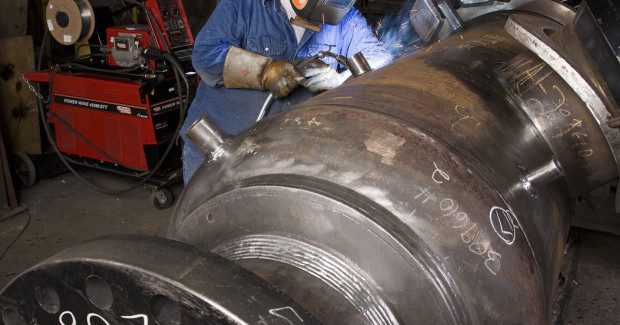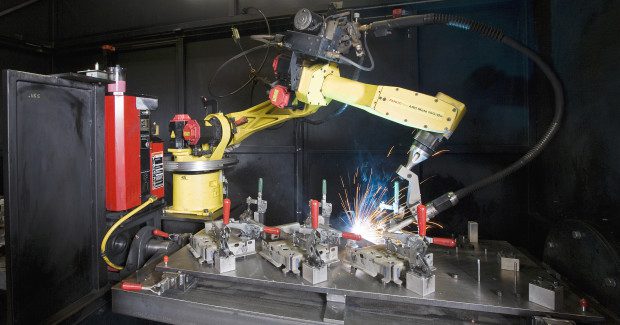The Higher Power Behind Power Sources
Many welders are still not aware that it is now possible to combine and capture all the information associated with their welding operation into one simple interface – their power source. This is the most advanced way to approach data acquisition and production monitoring in the welding industry.
Posted: February 19, 2013
Many variables can have a negative effect on your operation. Don’t let welding be one of them. With careful selection, it’s possible to combine all the information associated with a welding operation into one simple interface. These days, that interface, believe it or not, can be your welder.
Having this ability within your welder continues to be the most advanced way to approach data acquisition and production monitoring in the welding industry. It’s a novel idea that makes sense. Building on more than ten years of success, data acquisition and production monitoring systems that are internal to the welding power source can provide an increase in productivity and product quality.
When you take into account that such systems, through careful selection, are available already installed in your power source at no additional purchase cost, it can be hard to believe. But, it’s true. It’s the future of welding. The fastest of these data acquisition systems embedded in welding power sources operate at a 120 kHz sample frequency and can do things that you never thought of before – send e-mail alerts when welding limits are compromised or notify you that your 500 lb drum of welding wire is 10 lb away from going empty, to just name a few . . . all directly from the welder.
CONTROL YOUR PROCESS
Most welding fabricators “hope” that no one changes their weld parameters, and the “hope” is that any weld defects are visually caught and repaired before the piece in question reaches the customer. In this world, however, there are no guarantees. Having your welder help you control your welding processes can be a big deal. If and when quality issues, or worse, safety issues arise from less-than-perfect welds, you need some way to get your weld process back under control and prove it’s under control.
That’s exactly the kind of situation that calls for the power source to manage and monitor welding operations in your plant. Thanks to cloud technology, sharing that information globally is now easier than ever. Keep in mind that controlling your process is more than just measuring weld quality. It’s about understanding all the aspects that go into welding.
For example, understanding work center cost by tracking wire consumption per unit can help you control your process. You can set up welding variable limits like wire feed speed and weld duration. Monitor up time versus downtime on each welder. Ensure the correct weld settings are being used for each weld joint on your production weld floor. By creating unique names for each welder and setting welding limits for each application, tracking results is simple and effective. It’s all about knowing exactly what’s going on and being able to prove it.
ANALYZE AND MANAGE YOUR DATA
Thanks to cloud technology, having the opportunity to review welding information in real time, locally or remotely, across an entire global organization, is something new and unique. And, it is easier than ever. So, too, is the ability to customize memory names with Welding Procedure Specifications (WPS), Procedure Qualification Records (PQR), or any other pertinent information you can link to your welds. Internal power source software also provides you with tools like an oscilloscope to view actual welding current, voltage and wire feed speed.
In the past, you needed a high dollar oscilloscope, a 500 to 1500 amp current probe and a custom voltage filter to view this very specialized set of waveforms. Now it’s easily available through your welder on your laptop screen. These functionalities allow for quick diagnostics of welding equipment and the welding arc. Plus, you will know the status of your production by sorting welding data by shift, hour, day, week or month. You can share this data in more than 12 different languages.
You also can analyze last shift production information, such as number of welds, average current, average voltage and total arc on time for each power source on your network. It’s easy to do. Just click on a specific weld to drill down into the weld information in great detail.mIf your parts are serialized, it’s also possible to link the weld data of each weld to that exact part and add traceability. By selecting a particular part serial number, you can view the weld data in the traceability screens.
Another helpful feature allows you to analyze faults and downtime with high level reporting, as well as inspect all of the fault alarms made during a given period for evaluations and corrective action items.
ENHANCE YOUR PRODUCT QUALITY
Be sure to choose an integrated weld quality system that increases operational efficiency. Newer power sources integrate arc monitoring that looks at 30 to 50 internal control variables right at the arc, not at some external mounted sensors that only view current, voltage and, maybe, wire feed speed. Nothing knows what’s going on at the welding arc better than the power source controlling it!
A fast 120 kHz sampling rate provides more data in which to measure weld quality. Plus, these newer systems allow you to track your welds in three different ways. One way would be by weld ID or part serial number. A second way would be employee ID and third, by consumable lot number. Customizing welding variables and setting limits that comply with your specific Welding Procedure Specifications (WPS) or Procedure Qualification Records (PQR) is easy. Just train the system by making several “good” welds within your boundary limits.
An example would be to train the system with several welds with a new contact tip and with one that ran for eight hours. A contact tip that is worn will provide a different welding characteristic. Oily versus non-oily parts would be another. Electrical stick out (ESO) min and max would be another. The best systems are highly sensitive; make sure you take all the “good” variables into account.
Once you train your system on a sample of acceptable welds, it’s ready. If a weld happens to fall outside the “trained” definition of acceptable weld criteria a fault signal can be communicated (output) to the robot, PLC or operator. It then can be dealt with accordingly. Also, keep in mind that with a production monitoring system, your latest generation power source has the ability to send e-mail alerts when those welding limits are compromised. An e-mail alert can even be generated and sent out to specified individuals to directly respond to the work center if desired.
Please note, however, that in-process monitoring of weld quality is based on user-supplied criteria and is not a replacement for quality assurance procedures such as non-destructive testing. Most people are not aware that this technology is available. With careful selection, it’s possible to combine and capture all the information associated with a welding operation into one simple interface – your welder.







